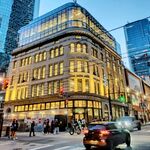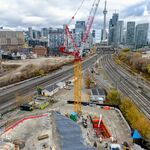I think I was somewhat misunderstood in the point I was trying to make in my post. Sorry for taking so long to reply.
The purpose of my original post was in response to one specific portion of your earlier post.
For major streets, the policy in Toronto is that the signal should rest in Walk until there's actually some specific reason for the light to end (either a timed end-of-green moment or someone detected on the side street). In which case there would only be Green + Don't Walk if there is currently a TTC bus/streetcar extending the green light (and the signal therefore doesn't know exactly when the green will end). But in some other places, including York Region, signals can also rest in Green/Don't Walk, which works really well at intersections with few pedestrians. In that situation, when someone is detected on the side street, the main street signal can immediately change to yellow, whereas in Toronto the person on the side street would first need to wait for the main street pedestrian countdown. If a pedestrian is detected on the main street while the signal is resting in Green / Don't Walk, the pedestrian signal can change immediately to Walk.
Just so we don't get confused which I think we did last time, let's say that the main street is Islington, and the side street is Jutland. Thus, a pedestrian who wishes to CROSS Islington is travelling on Jutland, while the pedestrian who wants to CROSS Jutland is travelling on Islington. The Islington/Jutland intersection is simple in that it's a simple RYG intersection with three signal heads, no protected turns or anything.
Therefore, Islington's phase, if we are going to have a rest on a steady "Don't Walk" would have three separate pedestrian "phases", which are of course
1. Green + Solid WALK
2. Green + Flashing DONT WALK (Countdown optional)
3. Green + Steady DONT WALK
Normally of course, signals rest in Phase 1 indefinitely unless the pedestrian call button (on the side street (Jutland) to cross the main street (Islington)) is pushed OR a vehicle is in the loop on the side street.
The point I was trying to make, if signals naturally rest in Phase 3, how does a pedestrian on Islington cross Jutland? As Islington wouldn't have a call button, (it doesn't need one as it's set up for semi-actuated) therefore my solution I presented was that the pedestrian on Islington would need to push Jutland's call button to get a walk signal again on Islington? (as that's the only way to return to Phase 1 as it would return there after Jutland gets its phase)
Unless you are implying that a call button should be installed on Islington? So if you push that call button, that the signal would return to Phase 1 (presuming Jutland's button isn't pushed and no vehicles are in Jutland's loops?)
On this site especially, people have a serious problem with call buttons and posters almost always refer to them as "beg buttons" as it's seen as having to ask a favour to cross the street. Ideally, wouldn't having less call buttons be more what the pedestrian ideally wants?
The pedestrian signal is not a signal for drivers. It is a signal for pedestrians. The amber interval for vehicle signals is determined such that it is sufficient for drivers to react to the start of the amber and reach the stop line if they are too close to stop considering the speed limit. Drivers do not need to jam on the brakes - the amber duration is based on a typical routine deceleration rate. If additional warning is desired, a flashing "prepare to stop when flashing" sign can be installed upstream which flashes just prior to the start of yellow.
Expecting the pedestrian signal to act as a signal for drivers is very problematic, because the two signals don't necessarily need to correspond with each other. For example, at high speed intersection approach, there will often be a detector about 4.5 seconds in advance of the intersection which holds the green for 3 seconds to prevent the light from changing to yellow while there is a vehicle in the 'dillemma zone' (where it's ambiguous whether to stop or not). This will produce Green + Don't Walk after the end of the countdown. Trying to guess when the light will change based on the pedestrian countdown will likely cause drivers to speed up or slow down, undermining the effectiveness of the dilemma zone protection.
Please stop expecting the pedestrian signal to be a signal for drivers. That is not what it is.
Drivers shouldn't use the pedestrian signal as a signal, sure. But there's many things that can be deduced from the current state of the pedestrian signal.
Heck, even when I did driver's ed, the instructor told me to be careful during a flashing don't walk, as the light could change soon. (This was in the era before countdown was mainstream)
There are a few universal truths (or rather axioms) that one can easily deduce by the state of the pedestrian signal, and I'm sure most drivers do pay attention to it somewhat, especially in suburbia.
1. A circular green along with a white walk signal being displayed means that the green phase will NOT end soon
2. When a countdown is shown, the green phase will NOT end on any number greater than zero.
While it is true, that the zero on the countdown will not necessarily immediately correspond to a yellow signal, the other two situations are always true.
I know that higher speed limits and line of sight lead to longer amber times, as I believe this is laid out in OTM Book 12, one of my main concerns is the rather seriousness from a legal standpoint the amber light holds in Ontario, and thus why it is important when to anticipate when the amber will occur.
Section 144 (15) plainly states that drivers must stop when they see an amber light unless they are unable to do so safely. There is a sort of dilemma zone in the mind of a driver as to when this point of safety exists. At what point is this safety point, does it mean if I can stop, even if I jam on the brakes, that I should do it. I could "safely" stop in that situation, and therefore I must do it.
(15) Every driver approaching a traffic control signal showing a circular amber indication and facing the indication shall stop his or her vehicle if he or she can do so safely, otherwise he or she may proceed with caution. R.S.O. 1990, c. H.8, s. 144 (15).
Advanced warning flashers can help, I understand that, but seeing a white light adjacent to the traffic light, let's me know that I won't have to worry about making a split second decision if I should stop or not.




